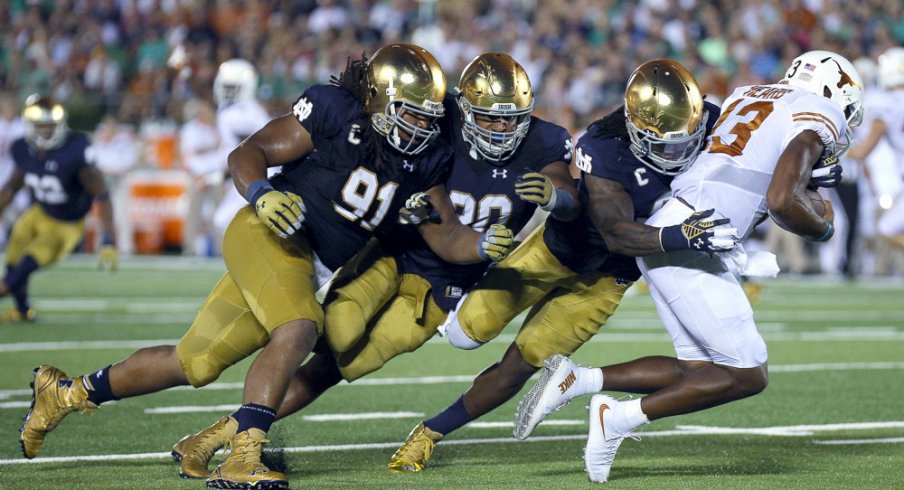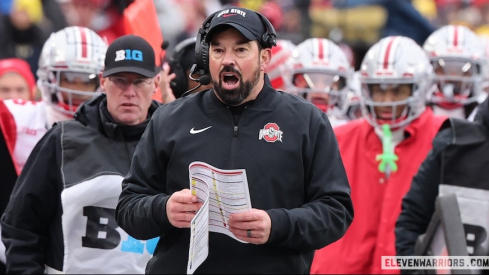Though head coach Brian Kelly has been known for bringing strong recruiting classes to South Bend during his tenure at Notre Dame, his defenses have failed to produce as consistently as one might expect. After finishing with a top-10 unit nationally in 2012, the year in which they played for a national championship, the Irish have struggled to regain that form since.
Gone is Bob Diaco, the architect of that outfit, who is now the head coach at UCONN, having taken his 3-4 scheme with him. In his place, former Atlanta Falcons defensive coordinator Brian VanGorder has installed a 4-3 defense that takes many different forms.
Given that the Fighting Irish play as independents, they aren't able to build their philosophy based on the prevailing scheme of a conference, such as the pass-heavy spread offenses of the Big 12 or power-run games of the SEC. Every year, Notre Dame is forced to game plan for pro-style looks from Stanford, USC, and Pittsburgh; 'power-spread' philosophies like Clemson, Temple, and Boston College; and even triple-option teams like Georgia Tech and Navy.
Much as an NFL defense is rarely able to rely on one scheme so heavily, in fear of showing a tendency that can be later exploited, the Irish are forced to build very different game plans from week-to-week. In theory, VanGorder's breadth of knowledge from the next level should provide Kelly's defense with the ability to adapt to whatever comes their way. However, the results this fall have been mixed.
| Yards-per-game | FBS rank | yards-per-attempt | FBS rank | |
|---|---|---|---|---|
| Passing | 195.7 | 28th | 6.90 | 58th |
| Rushing | 166.8 | 64th | 4.52 | 78th |
| Total | 362.4 | 39th | 5.54 | 63rd |
With so many different styles to plan for, it's no wonder that the Irish haven't proven to be particularly dominant in any one area defensively. Against Ohio State's powerful running game in the Fiesta Bowl on Jan. 1, we can expect them to approach that matchup much in the same way they did against the aforementioned 'power-spread' teams on their schedule.
Against the Tigers, Owls, and Eagles, VanGorder leaned heavily on star pupil Jaylon Smith. The former pass-rushing outside linebacker in Diaco's scheme has transitioned nicely to a role inside, leading the Irish in tackles by a wide margin and recording 30 combined stops in those three games.
In VanGorder's scheme, the Butkus Award winner plays a role very similar to the one Ryan Shazier played during his time in Columbus. Not only are the two players nearly identical in size and athleticism, but Smith (No. 9) is set up to be the 'eraser' for the Irish defense much the same way Shazier was, with the ball-carrier funneled his way on nearly every play. To do so, the remaining members of the Irish front seven play unceremonious roles for the better of the team, taking on blocks at the line to keep Smith free to read the play.
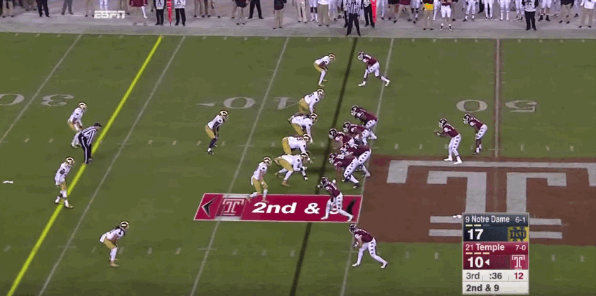
Though the Irish often appear to be in a 4-3 'under' look with the strong-side linebacker (SAM) playing up on the line, they're really playing a 5-2 look as that linebacker will almost always blitz off the edge in run situations. Additionally, the Irish like to take away inside runs by lining up in the 'Bear' front that the Buckeyes saw so often in 2014.
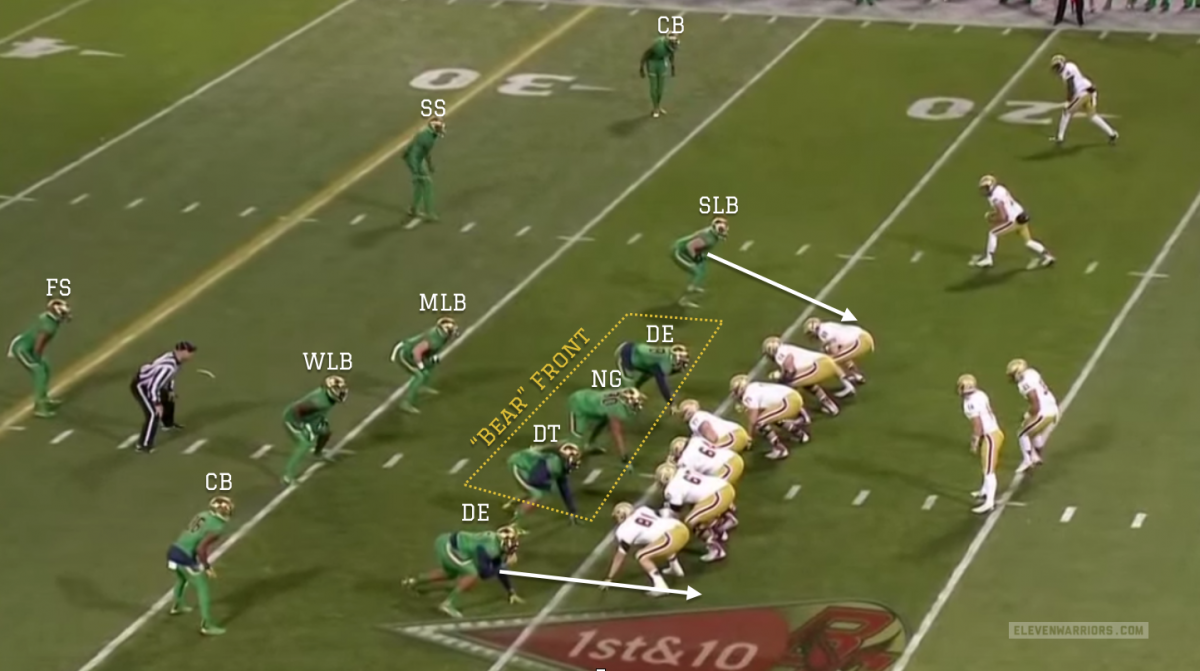
Not only does the SAM blitz on the outside, the middle linebacker blitzes inside, looking to add one more body to be blocked on an inside run.

The defensive end is left unblocked as the option man and plays his part perfectly, squeezing inside to play the run, knowing he has help coming. The Irish are executing a 'scrape-exchange,' as the man being optioned plays one possible outcome (the handoff in this case) no matter what, with another player (Smith) coming to fill the other option.
With so much traffic on the interior thanks to the blitzes from the other linebackers, Smith freely fills the gap and makes an easy tackle.

Smith has the requisite speed to make plays on the outside as well, and is given the freedom to roam and make plays on the edges without taking on blockers. However, he has a tendency to cheat on the option, opening up some big plays.
In this example, BC runs a variation of the 'Power read' concept, pairing an outside handoff with an inside keep for the quarterback. Smith reads the play the whole way, forcing the back into the waiting arms of middle linebacker Joe Schmidt (No. 38).

But later in the game, the quarterback keeps on this option, racing through the gap vacated by Smith who once again chased the handoff.

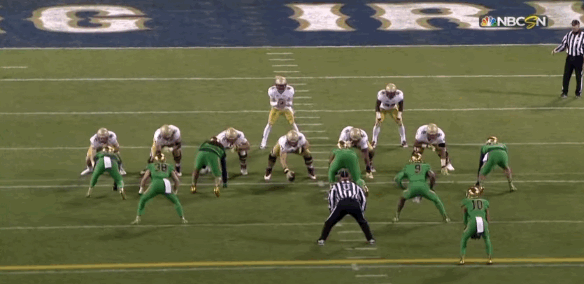
Both Smith and the safety, Max Redfield (No. 10) misread the play, but Redfield isn't usually counted on to make this tackle. Unlike the Buckeyes' system, Irish defensive backs aren't often called into run-stuffing duty, leaving that responsibility to the front seven almost exclusively when facing spread offenses.
Forcing Smith to move laterally seems to be the most successful way of stressing the Irish defense, as he's more likely to get stuck in the wash of blockers. Jet sweeps opened things up just this way for Clemson in their closely-fought contest in October.
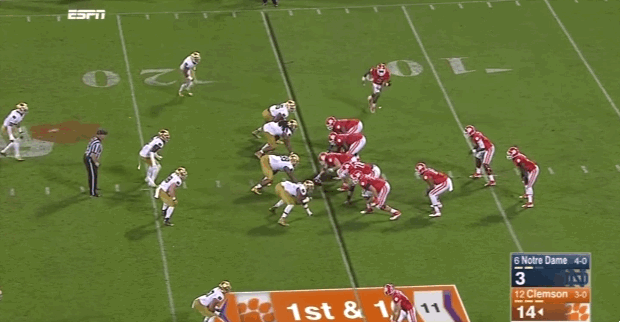
Schmidt and SAM linebacker James Onwualu (No. 17) both miss tackles on the play after fighting off blocks, and Smith is unable to get off his in time to make the stop. Once again, these moderate gains seemed to force the Irish into cheating as the Tigers would find the end zone later in the same drive. The jet-motion pulled the whole defense away from the play, opening up a wide open gap for a simple quarterback lead.
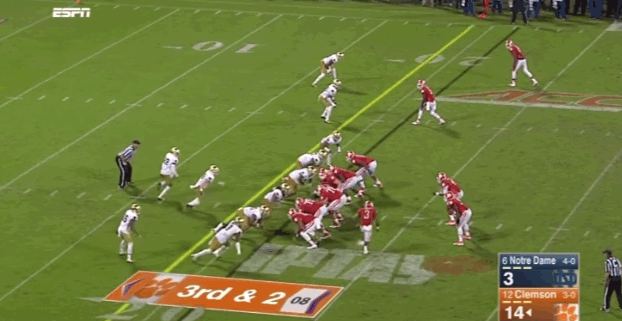
Even without motion, designed QB runs seemed to frequently gash the Irish. With a deep safety in the middle of the field and predictable blitzers coming from the edges, offenses were able to gain a numbers advantage by using the running back as a lead blocker, an area in which Ezekiel Elliott excels.

Although it may seem as though there is far too much burden placed on Smith's shoulders, there is good reason for doing so. Much of the personnel on the defensive front was recruited to occupy blocks in Diaco's '2-gap' 3-4 scheme, not to be penetrating '1-gap' defenders in a 4-3.
That group isn't without talent though. Seniors Sheldon Day (No. 91) at tackle and end Romeo Okwara (No. 45) have recorded double-digit tackles-for-loss this fall, however many of those came when rushing the passer. Additionally, those two often line up to the weak side right in front of Smith, concentrating much of Notre Dame's talent in one spot.
But it would be unfair to talk about the issues of the Irish defense this year without mentioning the near countless injuries that have stung the team as a whole. Three expected starters went down throughout the season with three more members of the two-deep joining them on the injured list.
With so many inexperienced players pressed into duty, the Irish have struggled to contain big plays on the ground. Often times, the failures are simply due to execution, such as failing to keep contain on a run, rather than scheme.

Make no mistake though, this is still a very talented defense, and the Buckeyes cannot simply show up and hope to run the ball. VanGorder will almost certainly have a plan in place to take away the basic components of the OSU run game, such as tight zone and Power.
The Ohio State offense must supplement those concepts with misdirection and options, much as they did against Michigan. Given the their inconsistencies through the air, the Buckeyes must establish a ground game early, setting up the Irish for those big plays that can come by over-running and mis-reading plays.
Running the ball is the strength of the Buckeye offense, and will go a long way toward controlling the game as a whole. The Irish offense is very similar to Ohio State's in this regard, built more on power running and play-action, controlling the game once they have a lead.
If last season was any indication of how the Buckeyes plan to respond, then the Irish should be in for a long day in Glendale. The OSU rushing attack against Alabama and Oregon was varied and creative, using both defense's tendencies against them. After hearing all year about how the departure of Tom Herman affected the Ohio State offense, this is a great opportunity for coordinators Ed Warinner and Tim Beck to silence the doubters.
